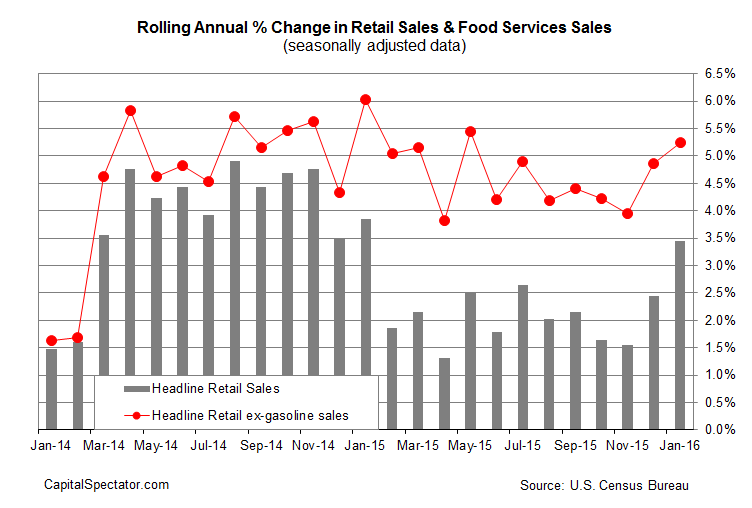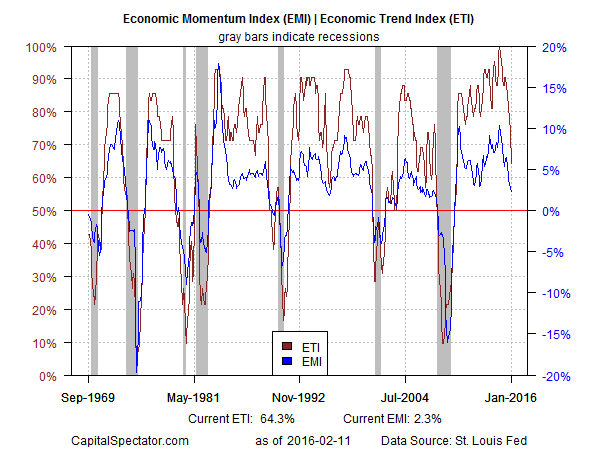US retail sales rose a moderate 0.2% in January, the Census Bureau reports. The gain offers another clue for thinking that the stock market’s plunge this year may be a false warning about the near-term macro outlook. In fact, when you look at retail spending’s year-over-year rate, today’s release shows a modest acceleration in the trend. To be fair, the early data for the January economic profile had been previously hinting at the probability that this year’s first month would escape the clutches of an NBER-defined recession. Friday’s report strengthens that view. February, of course, remains a mystery in terms of the available hard data at this point. Meanwhile, reviewing a broad set of indicators that reflects activity through last month—excluding market data—still aligns with an assumption that US economic growth will roll on.
The retail sector is certainly on board with an optimistic bias. As you can see in the chart below, the annual pace of growth for the headline data picked up, rising 3.4% in January vs. the year-earlier level. That’s the strongest increase in a year. Stripping out gasoline sales, which are fading in dollar terms, juices the year-over-year increase even more, to a healthy 5.3%. In short, there’s no sign of recession risk in the retail sales report for January.
Even at the peak of pessimism in recent days via the stock market’s plunge, it was reasonable to assume that the January economic profile writ large would remain sufficiently positive to avoid a recession signal. I’ve been making this point for weeks in The US Business Cycle Risk Report (including Thursday’s update). Consider, for instance, the Economic Trend and Momentum indexes (ETI and EMI, respectively), based on data published through Feb. 10 (the chart below appeared in Thursday’s edition of BCRR).
Both benchmarks are still above their respective tipping points (horizontal red line in chart above) and today’s retail sales report offers another data point that’s biased to the upside. But note too that ETI and EMI have been dropping sharply in recent months. That’s not especially surprising—near-term forecasts of ETI and EMI have been relatively soft since last autumn (see here, for instance). Yet based on the latest projections, both benchmarks are expected to remain above the red zone through April, albeit with the caveat of moving closer to the tipping point.
The US economy, in sum, is still trending positive and is expected to remain so until or if the incoming data tells us otherwise. Although a markets-based forecast looks grim (albeit slightly less grim this morning), a broad review of the macro data continues to point to growth. That’s clear in The Capital Spectator’s proprietary benchmarks and the upbeat message finds support in Thursday’s update of the Philly Fed’s ADS Index and the Atlanta Fed’s Feb. 9 estimate for +2.5% GDP growth in this year’s first quarter.
The stock market (aided and abetted by the rising high-yield spread over Treasuries) implies an alternative scenario, which may or may not be accurate. Peeking into the future is difficult and so Mr. Market isn’t immune to mistakes.
Yes, there’s a case for a relatively cautious outlook when it comes to risk allocations in money management. Indeed, that’s been true for some time (see here, for instance). But the jury’s still out on whether the recent anxiety attack in the markets marks a danger sign for the real economy.
The headwinds for macro are blowing a bit stronger–a shift that deserves close monitoring. But don’t confuse the implied markets-based forecast as a sure sign that the jig is up for the broad economic trend, at least not yet.
As always, mere mortals are forced to choose between two extremes: timely estimates of near-term economic actiivty and high-probability projections. Unfortunately, we can’t have both at any point in time.
Disclosure: Originally published at Saxo Bank TradingFloor.com


